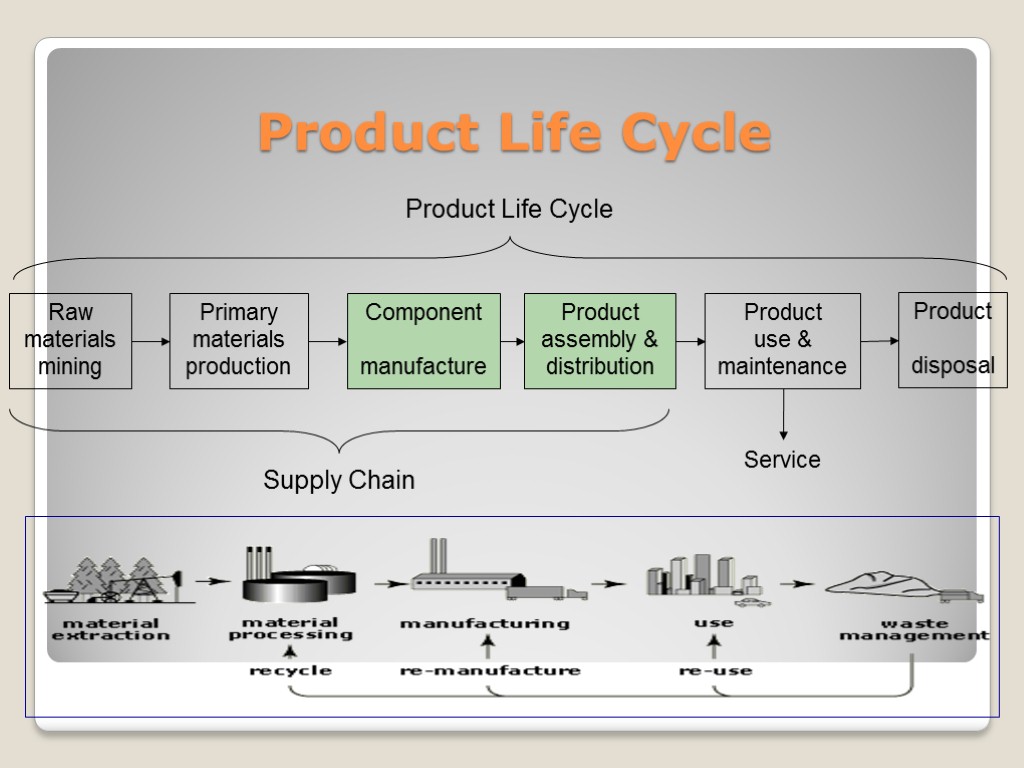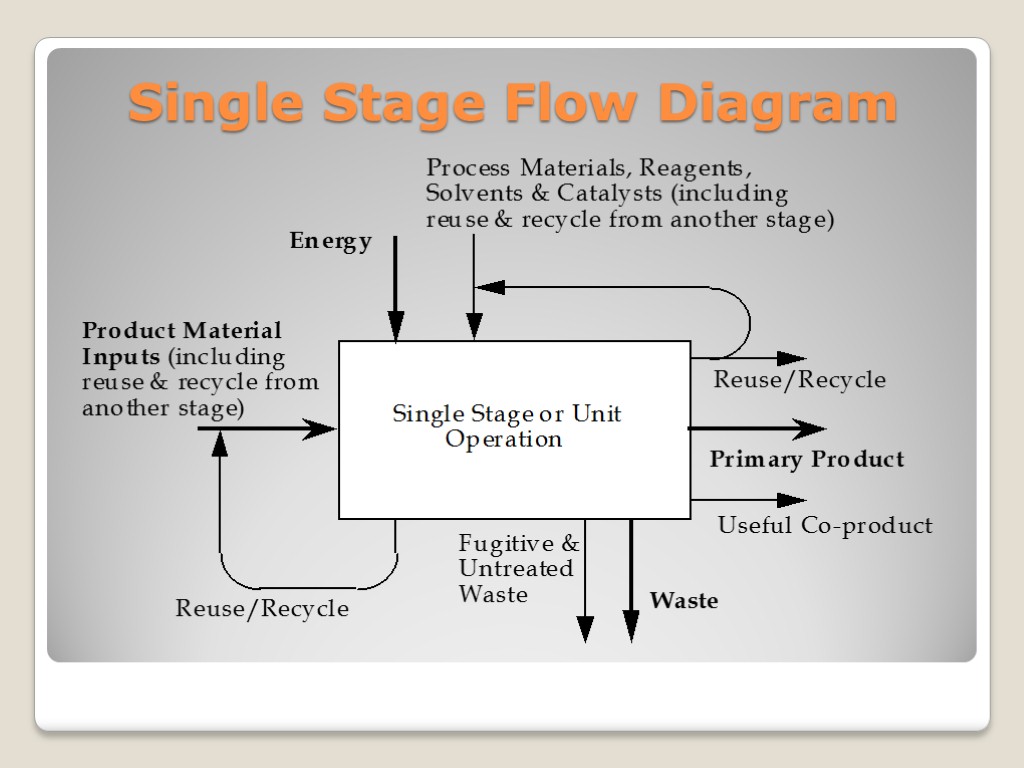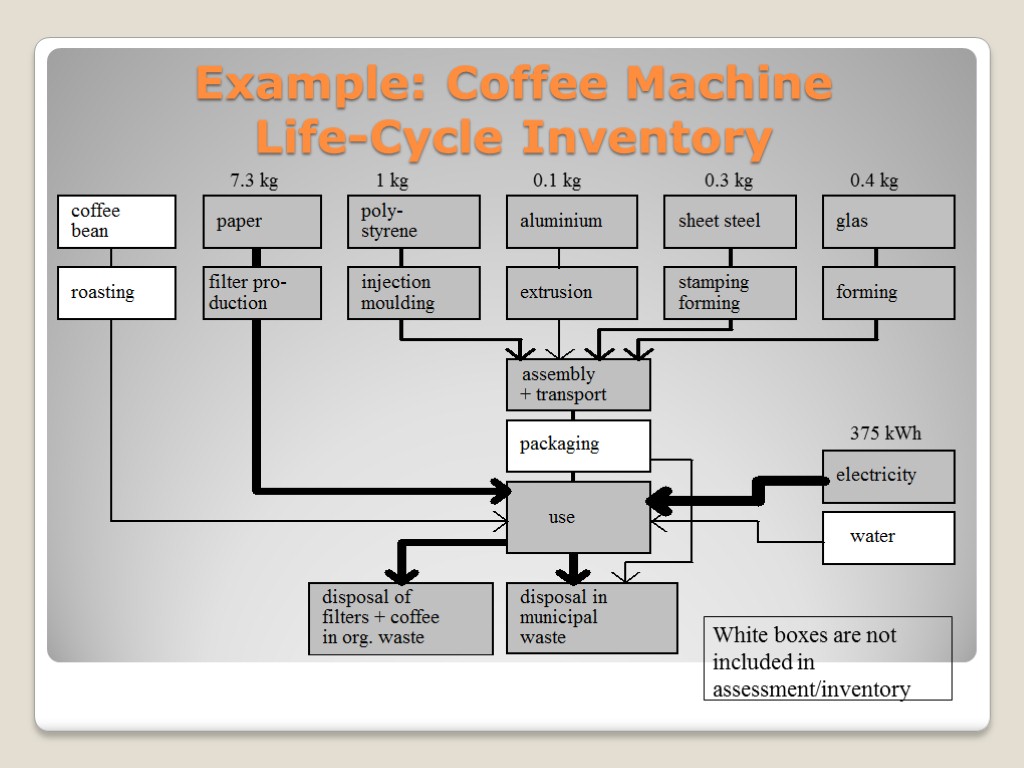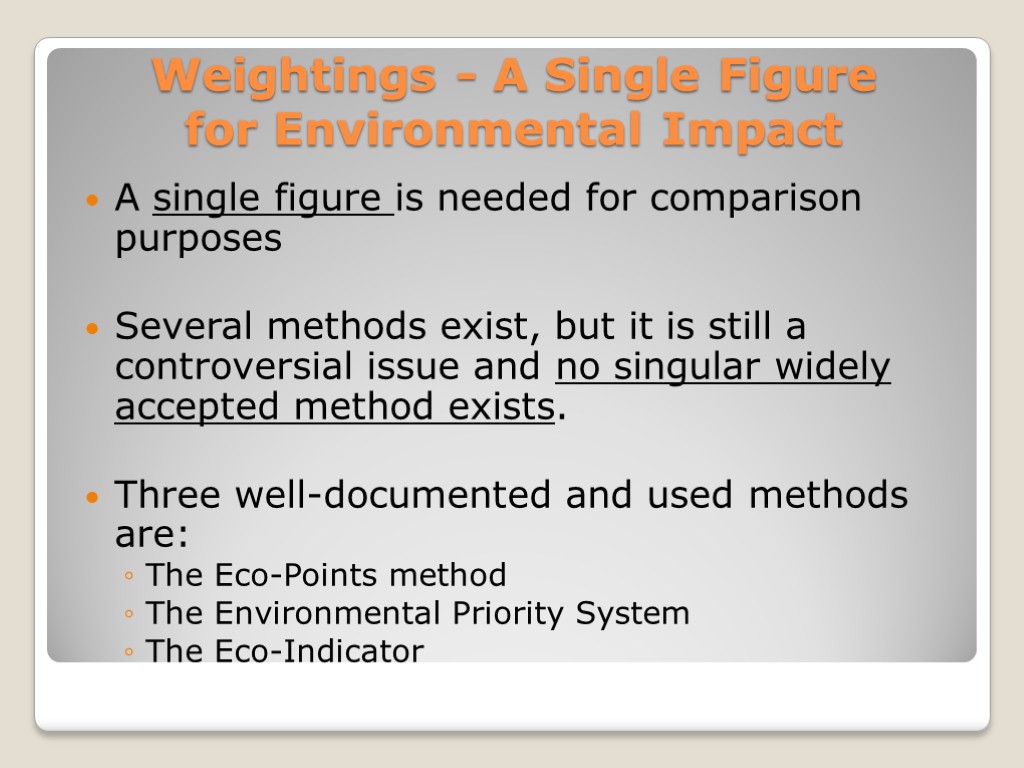Life-cycle Analysis/Assessment (LCA)Glossary Life-Cycle Assessment The technique whereby


Life-cycle Analysis/Assessment (LCA)

Glossary Life-Cycle Assessment The technique whereby the environmental impacts of a material, process or product are identified and assessed over its entire life-cycle Streamlined LCA An LCA with reduced scope such that only those issues considered to be of principal significance are taken into account Life-Cycle Inventory The result of gathering data on all the energy and material input flows required by a process or product and all the output emissions to air, water and land, including solid waste

Glossary Burden ‘Burden' is a term used to describe the materials and energy used to make, use or dispose of a product and the resultant emissions to air, land and water. A product may have many burdens associated with it, such as CO2 or wastewater, and therefore an inventory needs to be developed to identify them all Characterization The process by which the significance of a product's environmental burdens are quantified

Glossary Classification The process by which environmental burdens are grouped into impact categories such as acidification and global warming Environmental Impact Once a set of burdens has been identified for a product, it is useful to know something of the overall implications of those burdens. This ‘aggregated' consideration is referred to as the environmental impact

Glossary Impact Assessment The process by which burdens identified in an inventory are assessed so that an overall environmental impact can be identified Impact Categories Environmental burdens can have a number of potential effects on the environment, such as global warming, acidification and human health effects – these are called impact categories. To form an appraisal of the burdens, it is advisable to group the burdens into several impact categories to aid assessment

Glossary System Boundary When conducting an LCA, it is necessary to identify the limits of the study, i.e. how far back and forward in a product's life-cycle it is necessary to gather data. For example, in the case of a washing machine, upstream options include placing the boundary at the factory gate (i.e. the point where materials are received) or at the point where raw materials are extracted from the ground

Glossary System Flows The term used to denote the energy and material inputs to a process or product and the output emissions to air, water and land, including solid waste Valuation The process by which impact categories are assessed for their relative importance

Glossary COx A general term used to describe the oxides of carbon produced by the complete and incomplete combustions of organic matter such as coal, gas, biomass (wood, peat, etc.) and oil based materials NOx A general term used to describe oxides of nitrogen. Oxides of nitrogen are produced by the combustion of fossil fuels and certain industrial processes such as nitric acid works, electroplating etc. Nuisance An act or omission by a person which causes inconvenience, discomfort or harm to another person, e.g. noise, dusts, odours etc. The nuisance may be covered in statute law, or may be based on a common law judgement.

Life Cycle Analysis (LCA) Life-cycle analysis (LCA) is a method in which the energy and raw material consumption, different types of emissions and other important factors related to a specific product are being measured, analyzed and summoned over the products entire life cycle from an environmental point of view. Life-Cycle Analysis attempts to measure the “cradle to grave” impact on the ecosystem. LCAs started in the early 1970s, initially to investigate the energy requirements for different processes. Emissions and raw materials were added later. LCAs are considered to be the most comprehensive approach to assessing environmental impact.

Product Life Cycle Raw materials mining Primary materials production Component manufacture Product assembly & distribution Product use & maintenance Product disposal Service Supply Chain Product Life Cycle

LCA steps Generally, an LCA consists of four main activities: 1. Goal definition (ISO 14040): The basis and scope of the evaluation are defined. 2. Inventory Analysis (ISO 14041): Create a process tree in which all processes from raw material extraction through waste water treatment are mapped out and connected and mass and energy balances are closed (all emissions and consumptions are accounted for). 3. Impact Assessment (ISO 14042): Emissions and consumptions are translated into environmental effects. The environmental effects are grouped and weighted. 4. Improvement Assessment/Interpretation (ISO 14043): Areas for improvement are identified.

LCA steps

LCA standards

LCA standards

LCA standards

LCA standards

LCA Step 1 Goal Definition and Scope It is important to establish beforehand what purpose the model is to serve, what one wishes to study, what depth and degree of accuracy are required, and what will ultimately become the decision criteria. In addition, the system boundaries - for both time and place - should be determined. Thus, pay special attention to: Basis for evaluation (what and why) Temporal boundaries (time scale) Spatial boundaries (geographic)

LCA Step 2 - Inventory Analysis This means that the inputs and outputs of all life-cycle processes have to be determined in terms of material and energy. Start with making a process tree or a flow-chart classifying the events in a product’s life-cycle which are to be considered in the LCA, plus their interrelations. Next, start collecting the relevant data for each event: the emissions from each process and the resources (back to raw materials) used. Establish (correct) material and energy balance(s) for each process stage and event.

Single Stage Flow Diagram

Example: Simplified Process Tree for a Coffee Machine’s Life-Cycle

Example: Coffee Machine Life-Cycle Inventory White boxes are not included in assessment/inventory

Problems with Inventory Analysis The inventory phase usually takes a great deal of time and effort and mistakes are easily made. There exists published data on impacts of different materials such as plastics, aluminum, steel, paper, etc. However, the data is often inconsistent and not directly applicable due to different goals and scope. It is expected that both the quantity and quality of data will improve in the future. Mass and energy balances are not correct and defy laws of thermodynamics. Results are generalized improperly.

LCA Step 3 - Impact Assessment

LCA Step 4 - Improvement Assessment/Interpretation The final step in Life-Cycle Analysis is to identify areas for improvement. Consult the original goal definition for the purpose of the analysis and the target group. Life-cycle areas/processes/events with large impacts (i.e., high numerical values) are clearly the most obvious candidates However, what are the resources required and risk involved? Good areas for improvement are those where large improvements can be made with minimal (corporate) resource expenditure and low risk.

Weightings - A Single Figure for Environmental Impact A single figure is needed for comparison purposes Several methods exist, but it is still a controversial issue and no singular widely accepted method exists. Three well-documented and used methods are: The Eco-Points method The Environmental Priority System The Eco-Indicator

Eco-Points Method The eco-points method was developed in Switzerland and is based on the use of national government policy objectives. The evaluation principle is the distance to target principle, or the difference between the total impact in a specific area and the target value. The Eco-Points method is not so much an environmental indicator as an indicator “in conformity with policy”.

The Eco-Points Evaluation Method A low number of eco-points is preferred.

The Environmental Priority System (EPS) The EPS system was used first for Volvo in Sweden. It is not based on governmental policy, but on estimated financial consequences of environmental problems. It attempts to translate environmental impact into a sort of social expenditure. The first step is to establish the damage caused to a number of “safeguard objects” - objects that a community considers valuable. The next step is to identify how much the community is prepared to pay for these things, i.e., the social costs of the safeguard objects are established. The resulting costs are added up to a single figure.

The EPS Evaluation Method In: oil zinc Out: CO2 SO2 lead CFC value in EURO Impacts Safeguard objects Evaluation Result

The Eco-Indicator (95 and 99) The aim was to develop an easy to use tool for product designers and the main outcome was a list of 100 indicators for the most significant materials and processes. By using these indicators a designer can easily make combinations and carry out his/her own LCA. No outside expert or software are needed. Indicators have been drawn up for all life-cycle phases the production of materials such as steel, aluminum, thermo-plastics, paper, glass production processes, such as injection molding, rolling, turning, welding transport by road, rail, and sea energy generating processes waste processing processes, such as incineration, dumping, recycling. The most recent revised version is called Eco-Indicator 99.

Eco-Indicator 95 The evaluation method for calculating the Eco-Indicator 95 strongly focuses on the effects of emissions on the ecosystem. For the valuation, the distance to target principle is used, but the targets are based on scientific data on environmental damage and not on policy statements. The targets values are related to three types of environmental damage: deterioration of ecosystems (a target level has been chosen at which “only” 5% ecosystem degradation will still occur over several decades); deterioration of human health (this refers in particular to winter and summer smog and the acceptable level set is that smog periods should hardly ever occur again); human deaths (the level chosen as acceptable is 1 fatality per million inhabitants per year).

Eco-Indicator 95 Evaluation method

Weighting Factors Used in Eco-Indicator 95 *Setting equivalents for these damage levels is a subjective choice.

LCA use LCAs are used: in the design process to determine which of several designs may leave a smaller “footprint on the environment”, or after the fact to identify environmentally preferred products in government procurement or eco-labeling programs. Also, the study of reference or benchmark LCAs provides insight into the main causes of the environmental impact of a certain kind of product and design priorities and product design guidelines can be established based on the LCA data.

Softwares EPA website http://www.epa.gov/ORD/NRMRL/lcaccess/resources.htm#Software GaBi http://www.gabi-software.com/ Simapro http://www.pre.nl/default.htm

Closing Remarks It is not the product, but the life-cycle of the product that determines its environmental impact. Even if the life-cycle is mapped out, there still exist many uncertainties as to the environmental impact of the processes involved. There is still an immense lack of reliable data. Also consider uncertainties caused by customer behavior and (unknown) future process technologies. Knowledge about environmental systems is often highly uncertain. The LCA is generally a compromise between practicality and completeness
life-cycle_analysis_1.ppt
- Количество слайдов: 36

